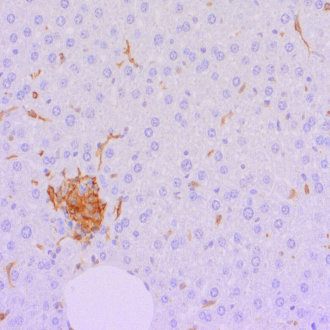
| Cat. No. HS-397 008 |
100 µl purified recombinant IgG, lyophilized. Albumin and azide were added for stabilization. For reconstitution add 100 µl H2O. Then aliquot and store at -20°C to -80°C until use. Antibodies should be stored at +4°C when still lyophilized. Do not freeze! |
| Applications | |
| Clone | Rb167B3 |
| Subtype | IgG1 (κ light chain) |
| Immunogen | Synthetic peptide corresponding to AA 28 to 42 from mouse F4/80 (UniProt Id: Q61549) |
| Reactivity |
Reacts with: mouse (Q61549). No signal: rat. Other species not tested yet. |
| Remarks |
This antibody is a chimeric antibody based on the monoclonal rat antibody clone 167B3. The constant regions of the heavy and light chains have been replaced by rabbit specific sequences. Therefore, the antibody can be used with standard anti-rabbit secondary reagents. The antibody has been expressed in mammalian cells. |
| Data sheet | hs-397_008.pdf |

F4/80 positive Kupffer cells in FFPE mouse liver. Immunohistochemical staining of a formalin fixed paraffin embedded mouse liver tissue section with monoclonal rabbit anti-F4/80 (cat, no. HS-397 008, dilution 1:100, DAB). Nuclei have been counterstained with haematoxylin (blue).